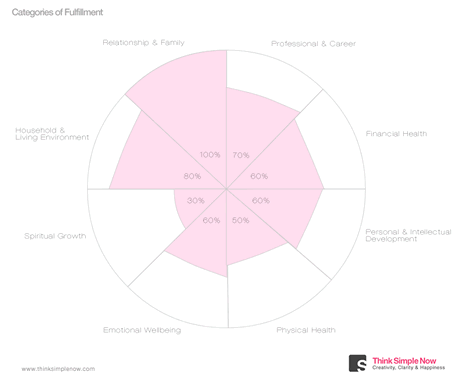Design Your Life

Are you tired of setting New Year’s resolutions only to find yourself faced with the same resolutions a year later? Don’t you just hate that feeling of guilt rising in your stomach at the thought of lost time, lost opportunities and lack of self-discipline?
I was at the gym last night and was shocked to see 3 times as many people there than normal. Rushing out of a locker room filled, hip-to-hip, with half-clothed ladies I’ve never seen before, I hopped on the last of twelve treadmills and gazed around the room in amazement – nearly every machine was occupied, the personal trainers were fully engaged, and there were countless new faces.
This is what I call “New Year’s Resolution Syndrome”.
It is well-known that gyms will overbook annual memberships at the start of each year, banking on the fact that many people will not follow through and will eventually stop showing up. Over the next few weeks, the traffic will slowly die down and the gym will be back to its normal and quiet self again.
What’s the problem here? The problem is that resolutions do not work. Especially the socially coined, “New Year’s Resolutions”. It’s a cliché that only 12% of people actually take action on and resolve.
What we need is a different approach. We need a system of designing our lives to sustainably improve the quality of our daily experience.
This article details a step-by-step system that I personally use for creating and living a balanced and meaningful life. Throw away ‘them TO-DO lists, and resolutions, because they don’t work – at least, they don’t last long enough to make a sustainable impact. Let’s drill down and focus on what really matters.
The Old Ways
First, let’s have a peek at why the old ways don’t work in creating a lasting impact on our lives.
Problems with New Year’s Resolutions:
I don’t know about you, but when I hear the words “New Year’s Resolution”, my stomach tightens in angst. Through years of failed resolutions, my association with these words has become “empty goals I don’t look at until next New Year”.
What’s the point of setting these goals if we don’t plan on taking them seriously? They shouldn’t even be called “goals”, they should really be called “wishful thoughts” instead.
Here are some common reasons why resolutions are not effective:
- We look at our list only once a year.
- We do not review the goals throughout the year.
- We don’t know why we want to achieve the goal.
- Not enough passion or reasons to motivate us into action.
- The goal is not specific. Too vague.
- The goal seems too large and overwhelming, so we never start it.
- We don’t actually want it.
- We do not come up with a plan to make it a reality.
Problems with To-Do lists:
Don’t get me wrong, I love to-do lists more than the average gal. However, due to their never ending nature (seriously, they never end), they are not the most effective way to manage our lives in a meaningful and balanced way.
When we feel unbalanced, it is truly helpful to list out the tasks that are weighing on us, in a to-do list, and categorize them on paper. Getting these things out of our heads and onto paper frees up mental capacity. Indeed, we can get a lot of stuff done with to-do lists, and they are a very helpful tool, but using the lists alone will leave us feeling unfulfilled because we end up chasing after a never ending to-do list and forget to live our lives.
Here are some common issues with using to-do lists alone to manage our lives:
- The sheer number of tasks can seem overwhelming.
- The list never ends and you will always have more items to add.
- Every item on the list appears to have the same sense of urgency. In reality, some tasks will bring more value and impact to your life than others.
- The purpose and motivation behind a given task is not clear.
- Selecting what to focus on becomes arbitrary, and we usually default to doing whichever’s easiest.
Live By Design, Not By Default
In trying to make the most out of our hectic lives, we may get caught up in the enthusiasm of crossing tasks off our to-do lists, and we disconnect from the knowingness that life is not about living by a to-do list, or ‘Getting Things Done’.
Chasing after tasks on our list can fulfill us temporarily, because it makes us feel busy and productive. It can also make us feel nervous, anxious and stressed.
We may be speeding through our list of tasks and feeling productive during the day, but when we get home at night, we realize that we are tired and unfulfilled. This is because we worked on arbitrary tasks that had no significance and meaning to us, and we focused on doing more and staying busy, instead of generating results that matter to us.
Assess Categories of Fulfillment
Before diving into setting goals, let’s gain some clarity on where we stand right now. On a blank sheet of paper, try this:
1. List out major areas of your life that are the most important to you. Come up with 4 to 8 areas. These are your major life categories. List them in no particular order.
Example 1, here are my categories:
- Relationship & Family
- Professional
- Financial
- Personal Development
- Physical Health
- Emotional Wellbeing
- Spiritual Growth
- Household & Living Environment
Example 2, categories of a friend:
- Family & Intimate Relationship
- Emotional & Spiritual Wellbeing
- Intellectual Development
- Time Management / Daily Routine
- Friendships
- Physical Development
- Financial Health
- Career Development
2. Do it quickly. You don’t need to over think this. You can always come back and redo this step.
3. Draw a large circle. Divide the circle up like a pie chart, where the number of pie pieces is equal to the number of life categories from above. (Alternatively, print out a blank chart with 8 categories: Image | Word Doc | PDF )
4. In each piece of the pie, write the name of one life category.
5. For each of the life categories on the circle, assign a rating out of 100% based on where you are today and where you want to ultimately be for that life area. How do you feel about it, versus how you want to feel in an ideal scenario. A 100% rating means you are completely satisfied, and 0% means you are completely dissatisfied. Write the percentage number down within each piece of the pie.
6. Draw a line within the pie to represent the percentage number in relation to how much of the piece of the pie has been filled up. The center of the circle is 0 and outer edge is 100.
7. Shade in the areas. This gives you a picture of where you stand in each of the life areas that are important to you.
As an example, here’s one I created for myself a month ago (Click on it for larger image):
Again, you can print blank pie charts with 8 categories here:
Image | Word Doc | PDF
Having this picture in front of us, we can clearly see the life areas we need to focus on in order to feel balanced. In reality, we can’t abandon any of these life areas for long without feeling imbalanced and unwell.
Now imagine that this is a wheel. How well will it roll? If it isn’t round, or close to being round, it will tip over, right?
What I love about drawing this picture is that we can capture and visualize the stress and psychological imbalance we’ve been feeling and carrying around with us. Having a visual representation helps to release some of that energy we’ve been grasping onto.
Pick one life area that makes you cringe. Alternatively, pretend you have this picture on the wall for all your friends to see. Which one makes you want to tear the picture off the wall? This is the area you should focus on first.
Step 1: Brainstorm Feelings
Let’s first connect with the feelings you want to experience this year.
On a blank sheet of paper, start jotting down all the feelings and personal impacts you want to experience this year. List them as they come to mind. Write them down without editing. Don’t worry about completeness or grammatical correctness, the main purpose of this step is to capture feelings in alignment with our desires.

Photo by Melissa Webb (See more images at her flickr stream)
You can use these questions to guide yourself:
- How do I want to feel?
- What do I want to experience?
Here is a blurb from my own brainstorm:
Clarity, organization, inner peace, improving the lives of others, authenticity, stress-free financial abundance, joy, living my passion, love, intimacy, laughter, changing lives for the better, connecting with my higher-self daily, tranquility, fulfillment, dancing, compassion, emotional mastery, simplicity, to help others, to surrender to the moment.
In writing down these feelings, not only are we glazing the stages of our lives with positive intentions, but we are also inadvertently creating visions for how we want the year to go.
Step 2: Select an Emotional Driving Force
Review your list from step 1, and underline 1-3 words that you connect with the most. You can either string them together or write a statement that includes these words (or feelings they imply) – the shorter, the better.
You can use these questions to help you:
- If I could choose one feeling or state of mind for the entire year, what would that be?
- What is the most important state of mind I would like to have regularly?
For example, I had, “Clarity & Inner Peace”.
Write this statement at the top of a new page. This is the most important state of mind you are after. Having identified this helps us focus on the emotions most important to us. Seeing this, also makes it convenient for planning and creating outcomes that provide these feelings.
Step 3: Capture Outcomes for the Year
Next, in bullet points, list outcomes, results, and achievements you would like to experience for the next year. We’re just capturing them on paper. Don’t worry about making it perfect.
Here are some of my personal outcomes for the year:
- To give engaging and captivating speeches in front of people. Training for public speaking.
- To feel connected with my inner self and live consciously on a daily bases.
- Become an early riser – starting the day feeling refreshed at 6am or earlier.
- To participate in a triathlon or similar event.
- To establish a productive, effective and healthy daily routine.
I recommend breaking up personal and professional outcomes into separate exercises.
Step 4: Planning Each Outcome
Let’s drill down into each outcome, and how we can make it a reality. Go through the outcomes from step 3 and for each outcome, fill out the following on a new page.
- Number it – Title it with an outcome number. ie. “outcome 1”
- Outcome Statement – Write the outcome next to the number. You can either copy what you had from step 3, or rephrase it using less words, or words that better capture what you want.
- Purpose – The reasons why realizing this outcome is important. List as many as you can in bullet points. Use words and phrases that excite you, that move you, and that inspire you.
- Categories of Fulfillment – From the wheel of life exercise above, we identified some major life categories. If this outcome was realized, which of these life categories will it contribute towards? Which category’s tank will it fill up? Feel free to list additional categories, even if it wasn’t identified on your wheel of life.
- Actions – List action-able items you must do to make the outcome a reality. Break these actions into smaller chunks or steps if necessary. Ideally, each item should take less than 1-2 hours to complete.
Please note that if your outcome is too vague or too big, it will be difficult to measure or remain motivated. Be specific and measurable (if possible). Use numbers and measurements.
If your outcome is big, or consists of many categories of to-dos, then we must break each sub-outcome into its own outcome block. For example, if you are planning a large wedding, you may have many areas that need to get done, and each area needs to be grouped as an individual outcome: booking a beautiful location, finding a flattering outfit, perfect accommodations for guests, etc. Similarly, if you are planning to elope, your may not have that many to-dos, and they can all be grouped under one outcome: An incredibly intimate and memorable wedding.

Photo: Thomas Hawk
Here is an example of an outcome planning block for myself:
- Outcome 3: Continuous Learning & Intellectual Development
- Purpose:
- To expand my horizon, to pickup new tools for my emotional toolbox, and to enhance my understanding of human transformation to better serve my readers.
- To be regularly motivated, inspired and challenged.
- To live a rich and fulfilling life with growth, contribution and purpose.
- Categories of Fulfillment: Emotional Wellbeing, Personal Development, Professional Growth.
- Actions:
- To read something for at least 30 minutes, everyday.
- Come up with a list of books I want to finish for the year.
- Organize my book shelf.
- Schedule tentative books I want to read each month in my calendar.
- Write down at the end of each day, what I learned or improved upon or contributed towards in that day.
Step 5: The Most Important Outcome
Give yourself a pat on the back for making it past step 4!! I’m so proud of you. And if you haven’t done it, take some time, go back and do it for yourself. Trust me, you will benefit from it.
Review each of your outcome blocks, especially each purpose and category of fulfillment. Pick the top 3 outcomes you really want to work on. Pick ones that will give you the biggest rewards for your efforts. Pick ones that contribute towards the life categories that need to be filled up the most.
These are the most important outcomes for the year – if you just got these outcomes done, you would feel like a complete rock star! Make these outcomes a priority.
That’s it! You’re done with the designing phase!
Tips for Following Through
Now that you have a beautiful year ahead of you, a plan for achieving the outcomes you want most, and reasons for why each outcome is important, the rest lies in your ability to follow-through and take consistent action towards results that mean the most to you.

Photo: Kevin Russ
Here are some tips:
- Weekly Review and Planning – Spend a set amount of time to review which outcomes you will work on this week. Evaluate your results from previous weeks. I will cover the weekly planning process in more detail in another article.
- Momentum – Take action every week (everyday if you can) regardless of how small, to keep momentum.
- One Outcome – Focus on just one outcome at a time. You can have other outcomes, but only work on them when you’ve completed tasks for the most important outcome.
- Review Often – Read over your written outcome blocks as often as you can in a day, in a week. Especially review the purpose, to be reminded of why each outcome is important to you.
- Visualize Outcomes – Before doing something, it helps to close your eyes for a moment to visualize the end result. When the outcome is a reality, how will you feel? How will you celebrate it? How big will you smile? Feel the feelings of excitement in your Being.
- Tell People About It – We are more likely to do something when we feel accountable for it. Let other people know what your up to, and you’re outcomes.
- Visual Reminders – Post your outcome and its purpose up where you can see them – walls, bathroom mirror, on your desk, etc.
- Find a Buddy – Find a buddy who is also working on something important to them. Become each other’s best support and motivator. Tell each other what you are currently focused on, why it is important and the actions you plan to take. On a regular basis, review your results with each other.
- Divide Annual Goals – Where would you need to be in 6 months, in order to achieve a particular outcome in a year? Where would you need to be in 3 months? In a month? Keep dividing annual goals, until you have a more realistic target to shoot for in the short term.
- Reward Yourself & Celebrate Successes – When you’ve succeeded in taking action or you’ve completed your outcome, don’t rush to work on the next outcome. Jump up and down! Treat yourself to something you enjoy (web surfing time, a snack, a stretch, a movie). Celebrate and give gratitude for your wins!
Parting Words
The art and act of designing your life is not just limited to the start of each year, nor is it set in stone. You are in control of your destiny. Instead of living in constant reaction and drifting between urgent demands on our to-do list, we have a choice to design and create a life with meaning and purpose.
It’s never too late to start drafting your life based on the areas that matter most to you. And you are free to adjust the sail at anytime as you navigate to sea. Instead of working off a big list of action items and arriving at an unpredictable outcome, start with a clear vision of the outcome you want, understand why it’s important to you, and then list the actions necessary to get that result.
Your destiny is in your hands. How will you design it?
** What are some of your most important outcomes for the year? Share your thoughts in the comment section. See you there!
[01/11/2009 Update]: The “wheel of life” technique came from the Tony Robbins UPW live seminar and the OPA (Outcome Purpose Action) planning technique came from Tony Robbins’ The Time of Your Life audio program on time management. The author does not claim credit for these concepts, but is merely iterating what has been helpful in her own life. Step 1 and 2 of this article are original concepts from the author.













